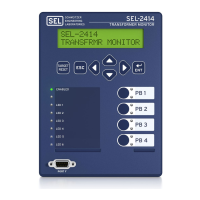
Do you have a question about the Sel SEL-2414 and is the answer not in the manual?
Safeguard transformers by tracking thermal conditions, calculating hot-spot temp per IEEE/IEC standards.
Monitor tap position and raise/lower controls using digital inputs in BCD or binary format.
Apply in harsh physical/electrical environments, withstands surges, fast transients, extreme temps.
Offers flexible I/O for status, alarms, measurements, and control functions with logic, math, timers.
Store SER reports, analyze trending and oscillographic event reports for diagnostics.
Automate fan bank control, integrate with SCADA via various protocols.
Measure voltage, current, power, energy, power factor, frequency, demand.
Front-panel HMI for configuration, displays settings, measurements, and calculated values.
Lists digital inputs for alarms like oil levels, pressure, gas; and status points like fan status.
Lists status points for fan/pump operation and OLTC control mode.
Details temperature inputs for ambient, top-oil, hot-spot, and bottom-oil measurements.
Lists common transformer alarms such as general alarm, oil level, pressure, gas accumulation, and relief device.
Lists digital outputs for fan bank control and equipment alarms.
Lists transduced quantities like tap position, top oil temp, ambient oil temp, bottom oil temp.
Record analog and digital waveforms at 32 samples/cycle for event analysis and troubleshooting.
Record measured ambient, top-oil, and hot-spot temperatures for trending with Analog Signal Profile.
Provides thermal modeling per IEEE/IEC standards for monitoring and protection of transformers.
Gathers through-fault current data to assess mechanical stress, insulation wear, and mechanical damage.
Front-panel simplifies commissioning via data viewing, diagnostics, and reduced troubleshooting time.
Offline settings development using an intelligent editor that enforces valid configurations.
Create SELOGIC control equations using a drag-and-drop or text editor for custom logic.
Virtual front panel for monitoring device status, I/O, alarms, and measurements.
Lists optional configurations for digital I/O, analog I/O, temperatures, ports, and protocols.
Supports flexible logic and integration with various protocols and serial ports for advanced automation.
Eliminates physical switches by using operator pushbuttons and menu system for control.
Replaces lights with programmable displays for custom messages and device status.
Replaces physical gauges with digital Max/Min metering for transformer temperatures.
Replaces physical relays with nonvolatile latch bits for control functions like remote enable.
Replaces external timers with 32 general-purpose SELOGIC control equation timers for custom logic.
Eliminates RTU wiring using remote bits for SCADA-type control operations.
Illustrates typical network configurations for Ethernet and EIA-485 communication.
Depicts typical serial and fiber-optic communication setups with SCADA masters.
Shows the front panel layout with buttons, LEDs, and port F for user interaction.
Details the rear panel layout with expansion slots and ports for I/O connections.
Identifies the physical connections for inputs and outputs on the side panel and their labels.
Provides dimensions for panel-mount installation, including the required panel cutout size.
Provides dimensions for surface-mount installation, including DIN rail mounting details.
Details compliance with FCC, UL/CSA, CE, and RCM standards for safety and regulatory requirements.
Covers operating temperature, environment, dimensions, weight, and frequency specifications.
Specifies AC current and voltage input characteristics, and DC transducer input specifications.
Details extended range options for DC transducer inputs, including impedance, accuracy, and sampling rate.
Specifies ON/OFF thresholds for various DC control signal voltages for input activation.
Specifies ON/OFF thresholds for various AC control signal voltages for input activation.
Describes specifications for the RTD input card, including channel count, types (PT100, NI100, CU10), and measuring ranges.
Details specifications for universal temperature cards supporting RTDs and Thermocouples, including ranges and types.
Lists DC output ratings, electromechanical and thermal contact specifications, and dielectric test voltage.
Specifies operational voltage, insulation, utilization category, and contact ratings for electromechanical outputs.
Details analog output ranges, impedance, accuracy, and step response for signal output.
Lists standard EIA-232 ports and optional Ethernet/Fiber-Optic ports and their characteristics like wavelength and fiber type.
Lists supported communication protocols like Modbus TCP, DNP3, IEC 61850, and Ethernet FTP for integration.
Specifies the maximum number of concurrent connections for Modbus Slave and DNP3 Outstation.
Details rated supply voltages and input voltage ranges for low-voltage and high-voltage models.
Lists AC and DC power consumption values for operational assessment.
Specifies allowable interruption times for low-voltage and high-voltage models during operation.
Provides accuracy specifications for current and voltage measurements, including phase, neutral, and sequence values.
Details sampling rates, filtering, and control processing for AC inputs and outputs for precise operation.
Lists environmental test standards including IP code, vibration, cold, damp heat, and dry heat compliance.
Specifies dielectric strength and impulse test requirements for electrical safety and robustness.
Details immunity to electrostatic discharge, radiated RF, fast transient, surge, conducted RF, and magnetic field interference.
Lists conducted and radiated emissions compliance standards for electromagnetic compatibility.
